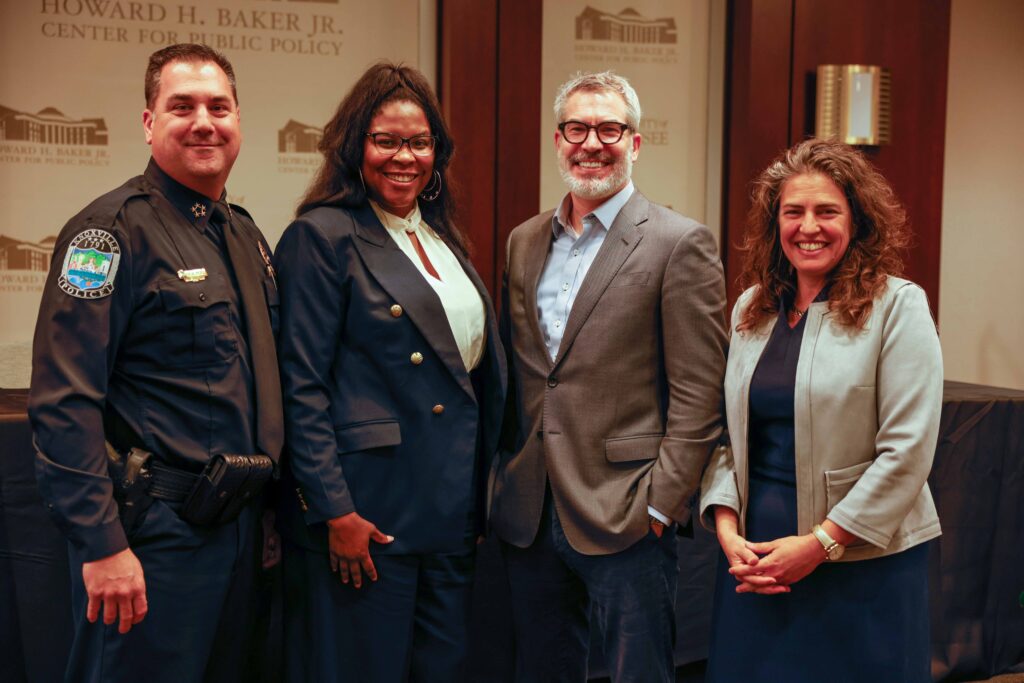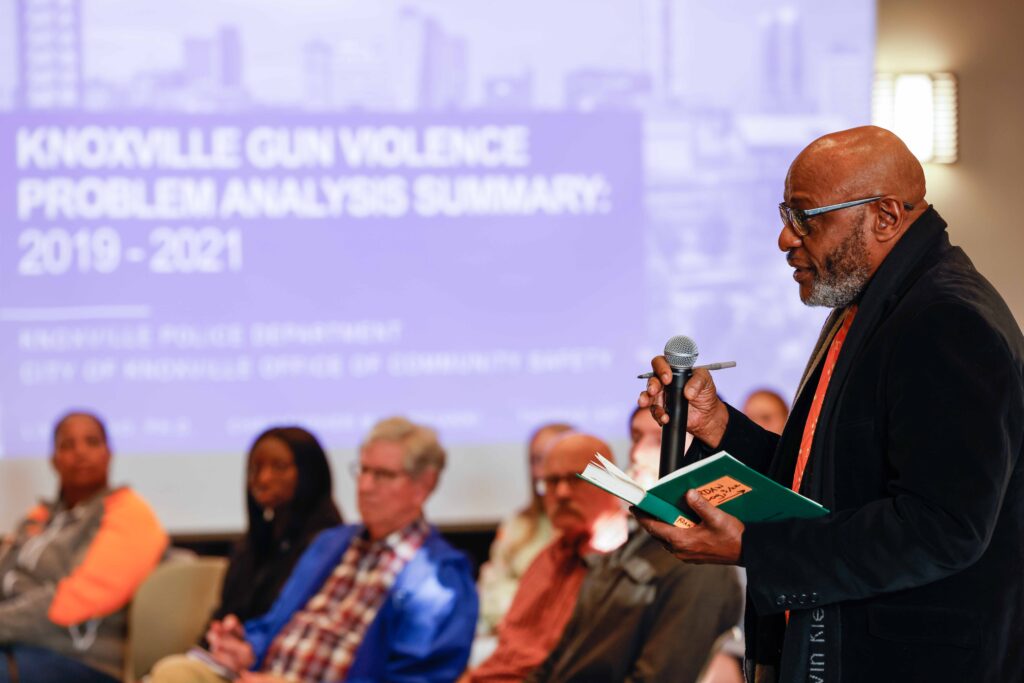Recap: Analyzing and Addressing Gun Violence in Knoxville – Key People, Places and Strategies

Recap: Analyzing and Addressing Gun Violence in Knoxville – Key People, Places and Strategies
To watch a recording of the event, click here.
On Wednesday, November 2, violence reduction expert Thomas Abt presented the findings of his research and recommendations to address the underlying causes of gun violence in Knoxville.
Abt joined Knoxville Mayor Indya Kincannon, Chief of Police Paul Noel and Community Safety Director LaKenya Middlebrook for a Howard H. Baker Jr. Center Public Square Series event.
Wednesday’s presentation and panel discussion was a follow-up to Abt’s first visit to the Baker Center in May, where he discussed the findings of his book, Bleeding Out: The Devastating Consequences of Urban Violence – And a Bold New Plan for Peace in the Streets.
Stating that “public safety was job one,” the mayor began the discussion saying the city needed to have a critical conversation about gun violence, and Abt was asked to come to Knoxville to research gun violence here.
Abt worked with officials during the summer to create a problem analysis designed to support the implementation of violence reduction strategies.
The Findings
The problem analysis used data from 2012 – 2021, with some analysis focusing specifically on the last three years, 2019 – 2021.
With a 10-year homicide rate of 12.9 percent Knoxville’s homicide rate is higher than the state of Tennessee’s rate, the case for many urban areas. From 2019-2021, Knoxville experienced 82 gun homicides and 188 nonfatal shootings. Between the victims and suspects, there were a total of 480 individuals combined. This analysis examined the characteristics of these incidents and the involved individuals.
Gun violence in Knoxville is shown to be overwhelmingly perpetrated by men, with the majority of victims also being men. The violence is taking place in clusters of the city that are considered the lowest income and with the most disadvantaged people, something found in other cities as well. The average age of suspects was 29 years old, older than what most people expect, and an average of 7.9 percent of suspects and victims had prior cases in the criminal justice system. This data is important because it shows a cycle among them – a victim today could be the suspect tomorrow. More than 12 percent of suspects were 17 years old or younger.
As it related to group involvement in gun violence for Knoxville, a significant amount of the victims were part of known groups. Only 12 percent of gun violence was officially tied to a group. However, 60 percent of incidents involved a group member – either a victim or suspect – meaning that it was an individual group member’s actions against an individual of another group. This is what often leads to group involvement gun violence, such as retaliation. The analysis identified 17 active groups in Knoxville, accounting for 2 percent of the city’s population.
The Recommendations
Abt noted that this is still early in the conversation. They plan to go deeper into this analysis and evolve these recommendations for success. KPD and the city need to assess their existing and future interventions to ensure that they focus on the people, places and circumstances that are driving the most violence. This can be accomplished by addressing those high-risk individuals, groups and locations, enhancing KPD investigative resources and developing collaborative responses.
Moving forward, Knoxville leaders should come together to identify a set of anti-violence strategies that are both evidence-informed and community-informed, Abt recommended. He suggested decision-making should be made by the best data on what works and what doesn’t and then bringing that to the community members to address the issues.
Abt’s “broken record” line is “collectively, these anti-violence strategies should be focused, balanced and fair.”
Analysis Reaction from Panel and Audience
Middlebrook was not surprised by the problem analysis. She saw consistency in what her team had seen in data and from speaking with the community. She believes that by using this data as a baseline for understanding how they can move forward as a community, they can point out the resources that are needed and who and where to serve them. She hopes that this will become an ongoing strategy.
Noel, who has been in his role for four months, had previously gone through this process during his time in New Orleans and was happy to be doing it again here in Knoxville. He believes this gives him and his force the opportunity to focus on the individuals and places where this violence is happening and work with the community in breaking the cycle of this violence.
The panel left plenty of time to discuss the analysis with the significant number of community members and students in attendance.
Abt was asked if he had seen any communities having continual success with preventing violence. He recalled that cities would have success for three to five years but then lose focus and progress. However, they never went back to where they had started, allowing them to be in a position to get back to being successful.
The discussion ended with a question that was well received by the audience: can Knoxville law enforcement officers be present in the community, not just to arrest people, so that people get to know them and feel safe when they see them? “That is exactly what our goal is at the Knoxville Police Department,” Noel responded. Since becoming police chief, he and his officers have been walking around the neighborhoods, Noel said. “That is what community policing is to me,” he added.
To read the full report go to www.knoxvilletn.gov/communitysafety.



